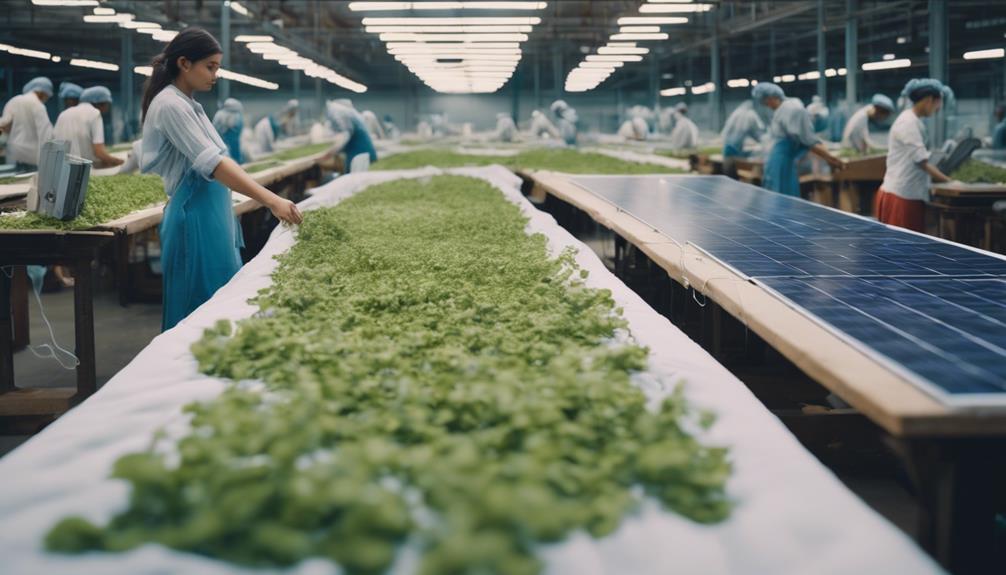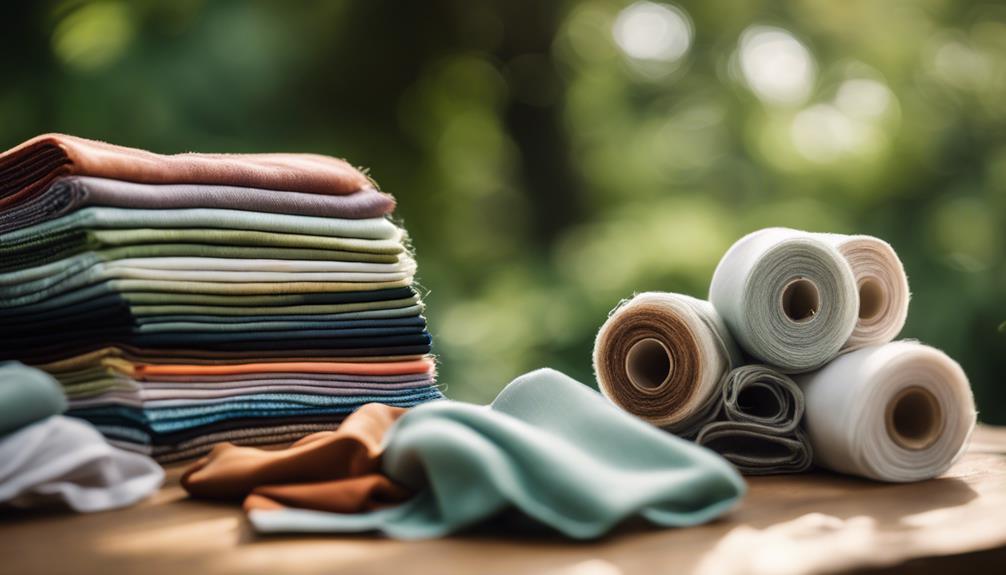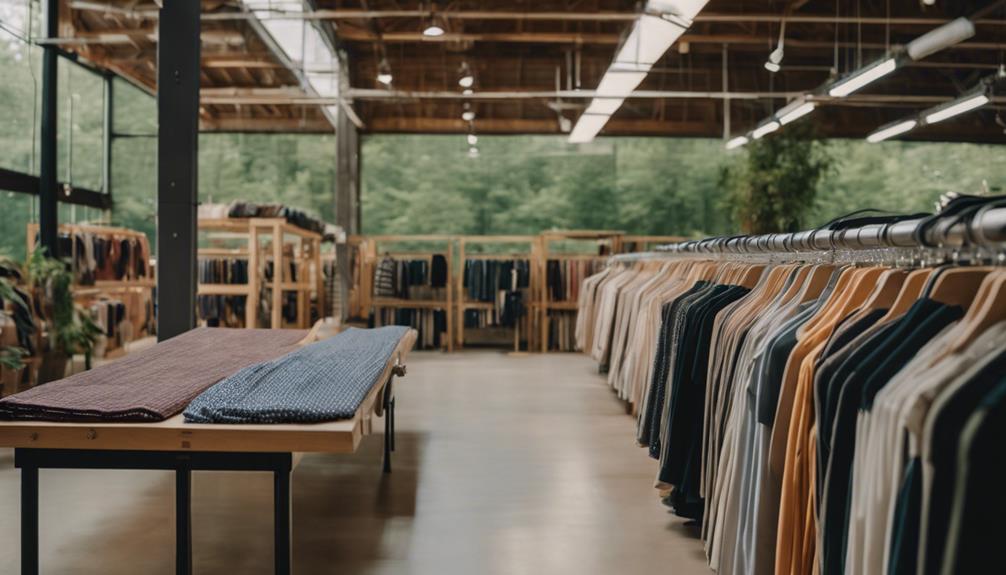Aritzia’s approach to sustainability raises eyebrows. While the brand markets itself as ethical, it relies heavily on synthetic materials, with their usage jumping considerably in recent years. This shift contradicts their sustainability image and brings environmental concerns, like microplastic pollution, into question. Furthermore, their labor practices lack independent verification, casting doubt on ethical treatment. Although Aritzia engages in community initiatives and aims for higher sustainability standards by 2025, the gap between its claims and practices remains troubling. If you’re curious about what this means for your wardrobe choices, there’s more to uncover about Aritzia’s practices and future.
Key Takeaways
- Aritzia's increased reliance on non-biodegradable synthetic fabrics contradicts its sustainability claims, raising concerns about environmental impact.
- The brand scores 21-30% on the 2023 Fashion Transparency Index, indicating a lack of independent verification for ethical labor practices.
- Despite donating over 100,000 garments and emphasizing community engagement, questions remain about the authenticity of Aritzia's sustainability initiatives.
- Aritzia aims to use 75% lower-impact materials by 2025, yet its current practices reveal a disconnect between goals and actions.
Aritzia's Brand Identity
Aritzia shapes its brand identity around premium, chic, and minimalistic fashion that resonates with Gen Z and Millennial women. This Canadian brand targets a style-savvy demographic looking for elegant yet accessible apparel. Aritzia's marketing strategies focus on fashionable minimalism, leveraging influencer partnerships to create buzz and engagement on social media platforms. By doing so, it cultivates a community that values both aesthetics and brand ethos.
While Aritzia positions itself as a sustainable fashion option, scrutiny surrounds its material choices and labor practices. You might find it concerning that, despite the premium label, the brand occasionally falls short of true ethical standards. This raises questions about whether Aritzia genuinely aligns with sustainable fashion principles or if it's simply capitalizing on the eco-conscious trend.
In a marketplace increasingly driven by transparency, your expectations for ethical practices are valid. Aritzia's reliance on in-store experiences and its chic offerings make it appealing, but the gap between its brand identity and actual labor practices could undermine its credibility.
Ultimately, you should scrutinize the brand's commitment to sustainability as you explore your fashion choices.
Sustainability Practices Overview

When you look at Aritzia's sustainability practices, you'll notice both progress and challenges.
While the brand has made strides in using lower-impact materials, concerns about material sourcing and environmental impact linger.
It's important to evaluate how these practices affect the overall sustainability of their offerings.
Material Sourcing Concerns
Growing concerns about material sourcing highlight the contradictions in Aritzia's sustainability claims, particularly with its rising use of non-biodegradable synthetic fabrics.
You've probably noticed that Aritzia's reliance on these materials increased from 36% to 44%, raising significant environmental concerns. While the brand does incorporate some lower-impact materials like organic cotton, the overall usage of cotton has actually decreased from 39% to 32% by 2023.
This shift is troubling, especially since Aritzia continues to use materials like rayon, viscose, and polyester, which are linked to marine life damage and chemical pollution. Such practices undermine any claims of sustainability.
Despite Aritzia's marketing emphasizing a commitment to sustainability, the increase in synthetic materials suggests a disconnect between their promises and actions.
Transparency in material sourcing also remains questionable, leading to skepticism about the brand's true environmental impact. You deserve to know where your clothes come from and how they affect the planet.
Until Aritzia addresses these material sourcing concerns, it's hard to fully trust their sustainability practices.
Environmental Impact Assessment
Evaluating the environmental impact of Aritzia's sustainability practices reveals a complex landscape where progress in lower-impact materials coexists with troubling increases in synthetic fabric usage. In 2022, 61% of their styles featured these materials, a notable rise from 44% in 2021. However, the brand's reliance on non-biodegradable synthetic fabrics has also surged from 36% to 44%, raising significant concerns regarding environmental degradation.
While Aritzia has made strides with sustainable denim aimed at reducing water usage, the broader implications of their synthetic materials persist. Critics point out the company's insufficient action to mitigate hazardous chemicals and a lack of transparency regarding material sourcing. This opacity complicates your ability to assess the true sustainability of Aritzia's practices.
Moreover, materials like rayon, viscose, and polyester contribute to environmental degradation through chemical pollution and harm to marine life, which is particularly troubling given the fast fashion industry's overall impact.
Ultimately, while Aritzia's initiatives show promise, their current approach doesn't fully align with a genuine commitment to sustainability. You must weigh these factors carefully when considering the brand's environmental impact.
Material Choices and Concerns

When you look at Aritzia's material choices, you'll notice a significant increase in their use of synthetic fabrics, which raises important environmental concerns.
Their claims about sustainability seem inconsistent, especially with a drop in cotton usage and continued reliance on materials linked to harmful practices.
Plus, the lack of transparency in material sourcing makes it tough to trust their commitment to sustainable fashion.
Synthetic Fabric Usage
Aritzia's increasing reliance on synthetic fabrics raises significant concerns about the environmental impact of these non-biodegradable materials. With the use of synthetic fabrics rising from 36% to 44%, you should consider how this affects sustainability.
Here are three key points to contemplate:
- Microplastic Pollution: Fabrics like polyester and nylon release harmful microfibers into waterways during washing, contributing to environmental degradation.
- Chemical Risks: The production of synthetic materials often involves toxic chemicals that pose health risks to workers and consumers alike.
Sustainability Claims Discrepancies
Despite Aritzia's claims of commitment to sustainability, the significant rise in synthetic material usage raises serious questions about the authenticity of these assertions. Their recent ESG Report reveals an increase in synthetic materials from 36% to 44%, which directly impacts the environment due to the non-biodegradable nature of these fabrics. Materials like rayon, viscose, and polyester not only contribute to marine life damage but also introduce hazardous chemicals into ecosystems.
Your concern might grow when you realize Aritzia's cotton usage has dropped from 39% to 32%. In 2022, only 61% of their styles featured lower-impact materials, highlighting an inconsistent approach to sustainable material sourcing. This reliance on synthetic materials seems at odds with their sustainability claims, especially in a time when fast fashion's environmental impact is under scrutiny.
Moreover, Aritzia faces criticism for its insufficient actions to mitigate hazardous chemicals in production processes. If you're looking for a truly sustainable brand, these discrepancies might make you reconsider Aritzia's position in the sustainable fashion landscape. Their current practices suggest a gap between their marketing and actual environmental responsibility.
Material Sourcing Transparency
Transparency in material sourcing is essential for understanding the true environmental impact of Aritzia's fashion choices, especially as concerns grow over their increasing reliance on synthetic fabrics. The brand's shift from natural to synthetic materials raises questions about sustainability and ethical practices.
Aritzia's use of synthetic materials jumped from 36% to 44%, contributing to non-biodegradable waste. This reliance on fabrics like rayon and polyester threatens marine life and increases chemical pollution. Furthermore, their cotton usage declined from 39% to 32% between 2021 and 2023, casting doubt on their commitment to sustainable practices.
Despite banning real fur and angora, Aritzia's ongoing use of synthetic alternatives poses significant environmental risks. The lack of transparency in material sourcing further undermines their sustainability claims.
If you're concerned about the fashion industry's impact on the planet, it's vital to scrutinize Aritzia's material choices. By understanding the implications of synthetic materials and their effects on the environment, you can make more informed decisions about your fashion purchases.
In a world increasingly conscious of sustainability, Aritzia's practices may not align with your values.
Ethical Labor Practices

Ethical labor practices are essential in fashion, yet Aritzia's claims lack independent verification and raise important questions about worker rights.
While Aritzia participates in the Sustainable Apparel Coalition and the Better Cotton Initiative, its actual transparency regarding labor standards in its supply chain remains questionable. Scoring only 21-30% on the 2023 Fashion Transparency Index indicates stagnation, leaving many concerned about how the brand guarantees the rights and safety of garment workers.
Moreover, Aritzia doesn't assure living wages for its workers, a critical aspect of ethical labor practices that many brands are aiming to achieve. Concerns about diversity and inclusion initiatives within their supply chain also linger, as there's no evidence supporting such efforts.
This lack of commitment to ethical standards raises doubts about the treatment of workers in their supply chain, especially in countries with known labor rights issues.
Community Engagement Initiatives

Aritzia actively supports local communities through various initiatives, donating over 100,000 garments to organizations like the Union Gospel Mission to assist homeless women in Vancouver. This impressive contribution represents a total donation value of $60 million, impacting over 700,000 individuals.
Aritzia demonstrates its commitment to community engagement and social responsibility through its Community Giving Program, which emphasizes philanthropic initiatives that empower local communities.
Here are a few ways Aritzia makes a difference:
- Customer Involvement: Aritzia encourages you to participate in their community initiatives, fostering a culture of giving.
- Partnerships with Organizations: By collaborating with various non-profits, Aritzia enhances its impact on the planet and promotes social awareness.
Through these efforts, Aritzia not only addresses immediate needs but also builds a sustainable future.
Consumer Engagement Strategies

To connect with shoppers effectively, Aritzia employs a mix of social media engagement and exceptional in-store experiences that foster brand loyalty and community. By leveraging platforms like TikTok and Instagram, the brand enhances its visibility and builds brand awareness among millennials and Gen Z. This strategy not only showcases their affordable pieces but also cultivates a participatory culture where consumers feel involved.
Aritzia's influencer marketing efforts, featuring popular figures like Kendall Jenner, draw significant attention and resonate with current fashion trends, further driving consumer interest. In-store, the brand focuses on creating personalized experiences that make you feel valued, which is essential for nurturing loyalty.
Moreover, Aritzia encourages feedback from its community, allowing customers to share their thoughts and experiences. This open dialogue strengthens engagement and aligns the brand more closely with its audience's preferences.
To top it off, Aritzia's subscription model offers exclusive content and deals, providing additional incentives for interaction. Through these strategies, Aritzia not only engages consumers but also builds a strong, loyal community around its fashion offerings.
Fast Fashion Comparison

The debate surrounding Aritzia's position in the fashion industry often centers on its blend of fast fashion traits and claims of sustainability. You might find it striking that Aritzia markets itself as a premium brand while employing production methods typical of fast fashion. This raises critical questions about its ethical standing.
Consider these factors:
- Aritzia's reliance on synthetic fabrics increased from 36% to 44% between 2022 and 2023, which contributes to environmental impact and overconsumption.
- In 2022, 61% of its styles incorporated lower-impact materials, but the use of toxic materials persists, undermining its sustainability efforts.
While Aritzia's pricing suggests a commitment to quality, its practices reveal a conflict between consumer demand and sustainable fashion principles.
The brand's current trajectory raises concerns about its long-term commitment to sustainability, especially when weighed against its reliance on synthetic materials and the environmental consequences of its production methods.
You must consider these aspects when evaluating Aritzia's true impact on the fashion industry.
Future Sustainability Goals

With a clear vision for the future, Aritzia is setting ambitious sustainability goals aimed at enhancing both environmental responsibility and ethical practices. The brand's commitment to sustainability initiatives is evident as it works to increase the percentage of styles made from lower-impact materials to 75% by 2025, up from 61% in 2022.
Here's a snapshot of Aritzia's future sustainability goals:
| Goal | Target Year | Focus Area |
|---|---|---|
| Increase lower-impact materials | 2025 | Material Sourcing |
| Reduce carbon footprint | Ongoing | Sustainability Initiatives |
| Eliminate fur and angora | 2023 | Animal Welfare |
| Enhance transparency in supply chain | Ongoing | Transparency |
Aritzia's Denim Forum line embodies these values, utilizing innovative technologies to notably reduce water usage during production. Additionally, the brand's commitment to ethical alternatives reflects its dedication to animal welfare, ensuring that its products align with consumer expectations for responsible fashion. By working for these goals, Aritzia is not just making a statement; it's taking actionable steps toward a more sustainable future.
Frequently Asked Questions
Is Aritzia Unethical?
You might find Aritzia unethical due to its low transparency scores, limited labor certifications, and questionable sourcing practices. Their use of animal-derived materials without oversight further complicates their ethical standing in fashion.
Does Aritzia Count as Fast Fashion?
With 44% of its materials being synthetic, Aritzia's rapid turnover of trendy styles makes it resemble fast fashion. While it offers higher quality, its practices still raise questions about sustainability and ethical production.
What Is the Most Sustainable Fashion Brand in the World?
When considering the most sustainable fashion brand, Patagonia stands out for its 100% recycled materials and environmental initiatives. Eileen Fisher and Tentree also excel, prioritizing eco-friendly practices and community engagement in their business models.
Is Aritzia Goose Down Ethical?
Imagine a cozy blanket, warm yet questionable. Aritzia's use of goose down raises ethical concerns. While they promote animal welfare, you might find their transparency lacking, leaving you wondering about the true cost of comfort.
Is Aritzia’s Fashion Line Known for its Longevity and Durability in Terms of Sustainability?
Aritzia’s fashion line is often praised for its longevity and durability in terms of sustainability. Their commitment to creating timeless pieces using eco-friendly materials demonstrates how sustainable fashion lasts. By using high-quality, sustainable materials, Aritzia’s fashion line is designed to endure the test of time, making it a sustainable choice for consumers.
Conclusion
So, is Aritzia really a sustainable choice?
While they've made strides in material selection and community initiatives, the truth about their fast fashion roots might leave you questioning your next purchase.
As you weigh the ethical implications of your shopping habits, consider what you truly value in fashion.
Will Aritzia's future goals align with your commitment to sustainability, or is it time to look elsewhere?
The choice is yours—are you ready to make it?









